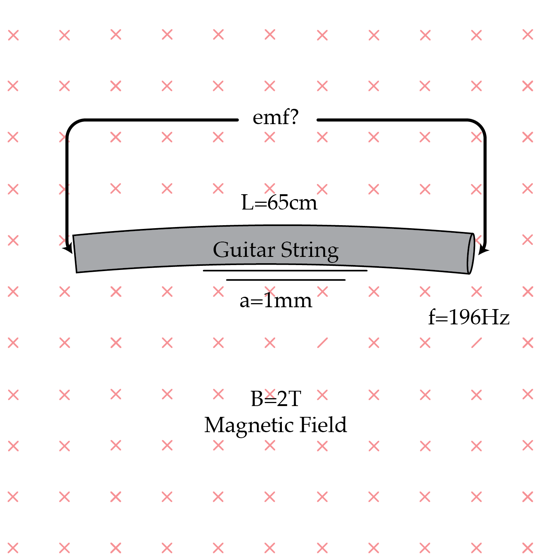Emf on the G string
The fundamental frequency of the G string of a guitar is f = 1 9 6 H z . The fundamental vibrational mode of the string is described by the standing wave y ( t , x ) = a cos ( 2 π f t ) sin ( L π x ) where L = 6 5 c m is the length of the string and a = 1 m m is the amplitude of the oscillations. What would be the peak emf in Volts induced across the ends of the string if the guitar is played in a B = 2 T magnetic field?
Assume that the magnetic field is perpendicular to the plane in which the string vibrates.

The answer is 1.
This section requires Javascript.
You are seeing this because something didn't load right. We suggest you, (a) try
refreshing the page, (b) enabling javascript if it is disabled on your browser and,
finally, (c)
loading the
non-javascript version of this page
. We're sorry about the hassle.
3 solutions
Faraday's Law of Induction states:
ε = − d t d Φ B .
where Φ B = B ⋅ A for a B-field perpendicular to the area plane.
Therefore, ε = − d t d Φ B = − d t d ( B ⋅ A ) = − B d t d A , since B is constant.
In this problem, the instantaneous flux area is determined by the vibrating string, where A = ∫ 0 L y ⋅ d x + C , where C is an unknown constant.
Accordingly, ε = − B d t d A = − d t d [ ∫ 0 L y ⋅ d x ] .
Given y ( t , x ) = a cos ( 2 π f t ) sin ( L π x ) , ∫ 0 L a cos ( 2 π f t ) sin ( L π x ) ⋅ d x = − π a L cos ( 2 π f t ) cos ( L π x ) ∣ 0 L = − π 2 a L cos ( 2 π f t ) .
Therefore, d t d A = 4 f a L sin ( 2 π f t ) .
Finally, ε = − B d t d A = − 4 B f a L sin ( 2 π f t ) .
At maximum amplitude, ∣ − sin ( 2 π f t ) ∣ = 1 . Therefore ε m a x = 4 B f a L = 4 ( 2 T ) ( 1 9 6 s − 1 ) ( 0 . 0 0 1 m ) ( 0 . 6 5 m ) = 1 . 0 1 9 2 V .
The magnitude of the emf can be found from Faraday's Law E = − d t d Φ = − B d t d A where A is the area swept out by the string. For a given time t, the area under the curve y ( t , x ) = a cos ( 2 π f t ) sin ( L π x ) is simply A ( t ) = ∫ 0 L y ( t , x ) d x = π 2 a L cos ( 2 π f t ) . Therefore the emf is given by E = 4 a L B f sin ( 2 π f t ) → E p e a k = 1 V .
We know that the induced e m f in a conductor moving in a magnetic field is calculated by e m f = L B v , where L is the length of the conductor in the magnetic field, but since the string’s vertical speed v ( t , x ) is not the same everywhere along its lenght, this formula becomes
e m f = B 0 ∫ L v ( t , x ) d x To obtain the velocity v ( t , x ) , we take the derivative of y ( t , x ) with respect to t .
v ( t , x ) = ∂ t ∂ y ( t , x ) = − 2 π a f sin ( 2 π f t ) sin ( L π x )
Substituting this into the integral for e m f yields:
e m f = B 0 ∫ L ( − 2 π a f sin ( 2 π f t ) sin ( L π x ) ) d x =
= − 2 π B a f sin ( 2 π f t ) 0 ∫ L sin ( L π x ) d x =
= − 2 π B a f sin ( 2 π f t ) [ − π L cos ( L π x ) ] 0 L = − 4 L a f B sin ( 2 π f t )
We see that this is the formula for an alternating voltage, and we want to find the peak value. And since − 1 ≤ s i n ( θ ) ≤ 1 , ∀ θ ∈ R , we can see that the expression above is maximal when sin ( 2 π f t ) = − 1 (or + 1 , the sign doesn’t really matter, it only shows in which direction the current is flowing), which gives:
e m f m a x = 4 L a f B
Plugging in numbers (in SI units) gives:
e m f = 4 × 0 . 6 5 × 0 . 0 0 1 × 1 9 6 × 2 = 1 . 0 2 V